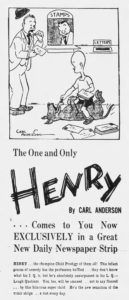Carl Anderson’s Henry Debuts March 19, 1932
Skip to commentsNinety years ago Carl Anderson, at age 67, became an overnight success.
Well, his comic character Henry became an overnight success.
Carl had been toiling in various newspaper art departments for 40 years
and trying to hit the big time as a cartoonist for at least 30 of those years.
Art Baxter relates Carl Anderson’s struggles:
He got a job drawing fashion illustrations for the PHILADELPHIA TIMES at the age of 29 in 1894. A dozen or so years later, he was offered a job drawing for the NEW YORK WORLD Sunday pages where he created a comic strip called “The Filipino and the Chick.” The strip’s life was cut short when he was scooped up by the NEW YORK JOURNAL and put to work on a comic strip called “Raffles and Bunny” for the Sunday edition. “Herr Spiegelberger, the Amateur Cracksman” was another new strip he created in 1903 for the McClure Syndicate. These early comic strips did not catch on. Anderson turned to freelancing gag cartoons for PUCK, LIFE and JUDGE for the next 25 years.
Allan Holtz details those comics strips and a few others Anderson tried in the early 20th Century.
Not able to survive on his freelance cartoon earnings Carl retired back to his birthplace.
Art Baxter again:
The 64 year old Anderson found the markets shrinking and his income greatly reduced by the time of the stock market crash in 1929. He left New York City for good in 1932 having exhausted his prospects.
Anderson returned to his home town of Madison to attend to his dying father. He considered returning to cabinet making as a source of income, falling back on woodworking skills he had learned as a young man. In the meantime, he began to teach a night school cartooning class.
William H. Foster, for Hogan’s Alley magazine, takes up the story:
One night, in the spring of 1932, Anderson’s students at the Madison Vocational School crowded around a classroom drawing board and watched as the cartoonist drew a sway-backed, pot-bellied horse. Two boys stood beneath the horse, one holding the other against the horse’s stomach, to warm his bald head. The caption: “Does your head feel warmer now, Henry?”
above: first Henry cartoon in the Saturday Evening Post
Anderson sent the cartoon to the Saturday Evening Post, which bought it for $50. More Henry panels followed, and the cartoon became a regular feature of the magazine. It grew so popular that Henry dolls were manufactured.
That first Henry drawing appeared in the Saturday Evening Post dated March 19, 1932. It quickly became a regular feature and soon was given the prime spot on the back page of the magazine (a spot that later featured Marge’s Little Lulu and Ted Key’s Hazel).
The aforementioned Art Baxter has a wonderful gallery of the Saturday Evening Post panels.
Henry got Anderson his dream: a popular magazine panel.
That in turn was transformed into a very successful comic strip when the Hearst
organization convinced Carl to turn the panel into a multi-panel newspaper comic.

above: Henry debuts as a syndicated comic strip December 17, 1934
below: by the second strip Henry was speaking – that didn’t last 
Carl Anderson had Don Trachte helping from the beginning of the comic strip. John Liney joined the strip in the 1930s. Eventually Jack Tippet and then Dick Hodgins would become the daily cartoonists until that ended in 1995 (1990?). Don Trachte continued as Sunday cartoonist until 2005 (1995?).
King Features would distribute reruns until 2018.













Comments
Comments are closed.